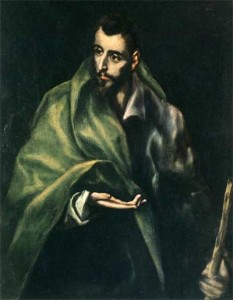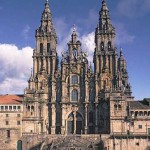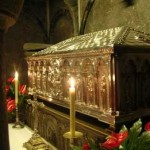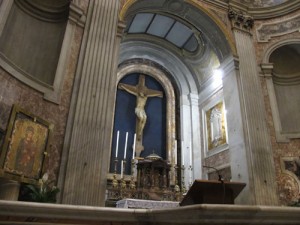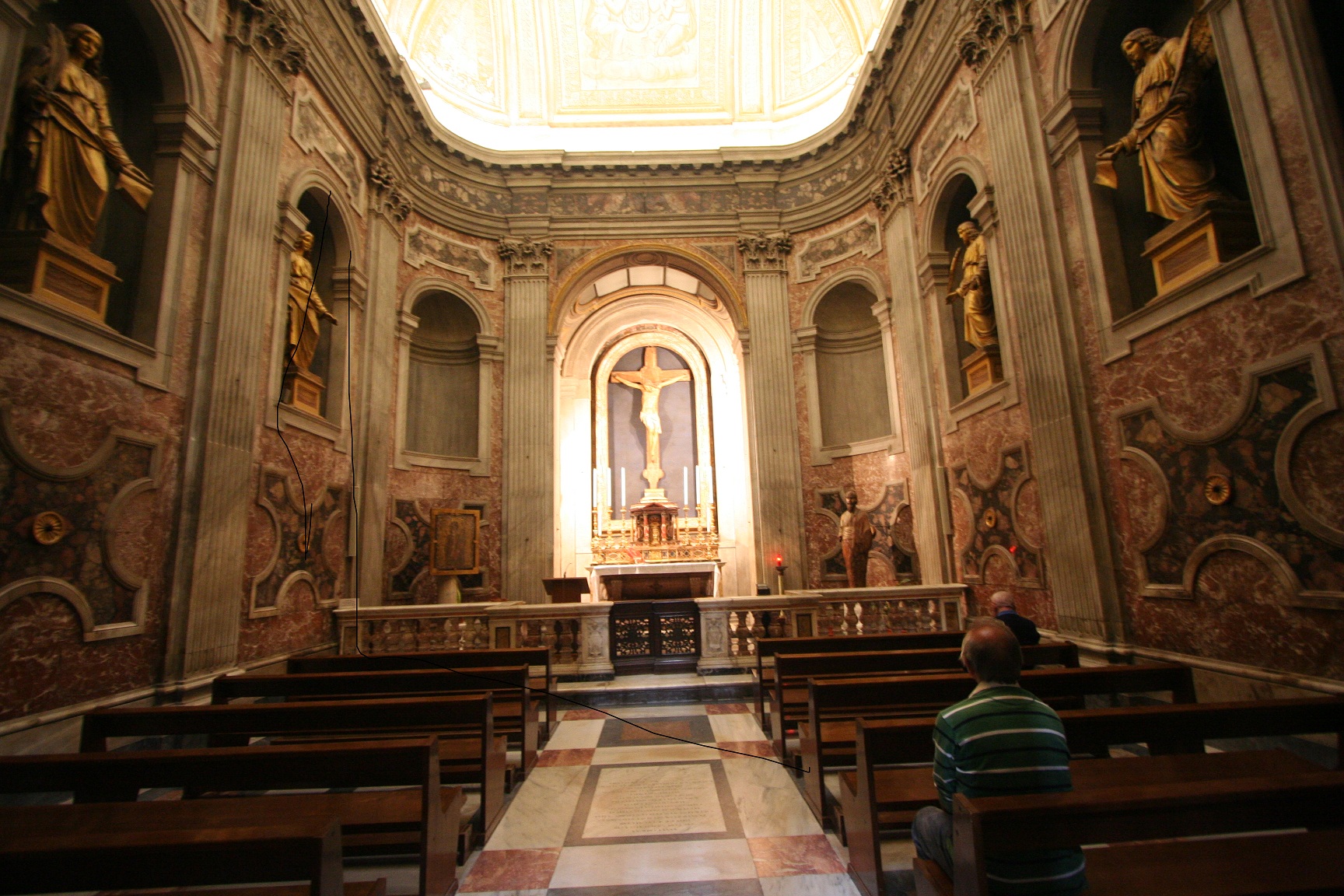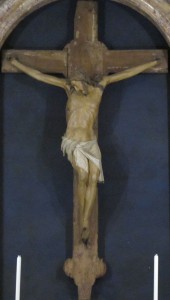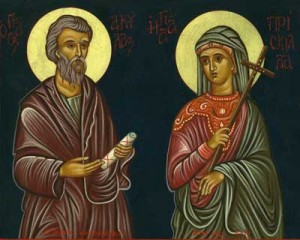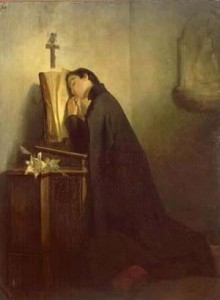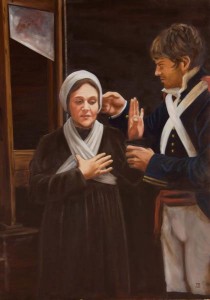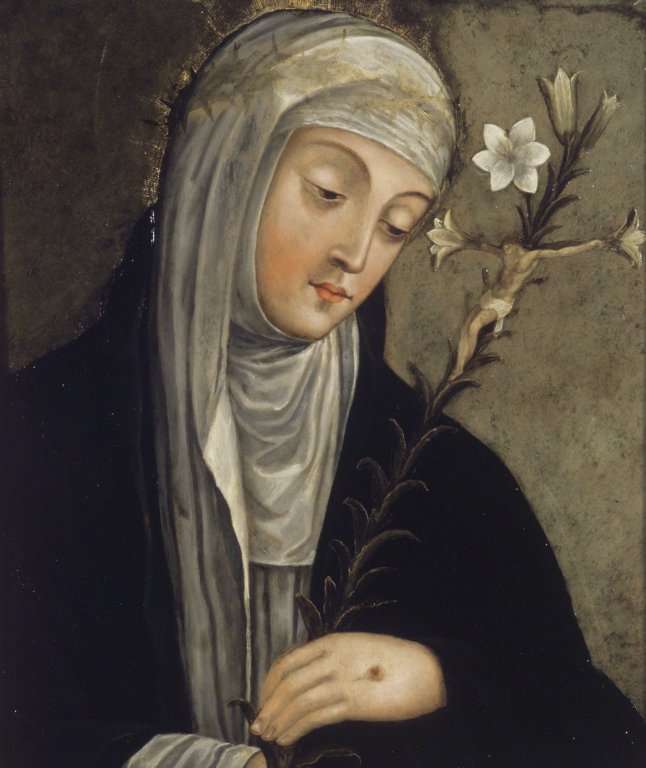BENEDICT XVI
GENERAL AUDIENCE
Wednesday, 21 June 2006
James, the Greater
We are continuing the series of portraits of the Apostles chosen directly by Jesus during his earthly life. We have spoken of St Peter and of his brother, Andrew. Today we meet the figure of James. The biblical lists of the Twelve mention two people with this name: James, son of Zebedee, and James, son of Alphaeus (cf. Mk 3: 17,18; Mt 10: 2-3), who are commonly distinguished with the nicknames “James the Greater” and “James the Lesser”.
These titles are certainly not intended to measure their holiness, but simply to state the different importance they receive in the writings of the New Testament and, in particular, in the setting of Jesus’ earthly life. Today we will focus our attention on the first of these two figures with the same name.
The name “James” is the translation of Iakobos, the Graecised form of the name of the famous Patriarch, Jacob. The Apostle of this name was the brother of John and in the above-mentioned lists, comes second, immediately after Peter, as occurs in Mark (3: 17); or in the third place, after Peter and Andrew as in the Gospels of Matthew (10: 2) and Luke (6: 14), while in the Acts he comes after Peter and John (1: 13). This James belongs, together with Peter and John, to the group of the three privileged disciples whom Jesus admitted to important moments in his life.
Since it is very hot today, I want to be brief and to mention here only two of these occasions. James was able to take part, together with Peter and John, in Jesus’ Agony in the Garden of Gethsemane and in the event of Jesus’ Transfiguration. Thus, it is a question of situations very different from each other: in one case, James, together with the other two Apostles, experiences the Lord’s glory and sees him talking to Moses and Elijah, he sees the divine splendour shining out in Jesus.
On the other occasion, he finds himself face to face with suffering and humiliation, he sees with his own eyes how the Son of God humbles himself, making himself obedient unto death. The latter experience was certainly an opportunity for him to grow in faith, to adjust the unilateral, triumphalist interpretation of the former experience: he had to discern that the Messiah, whom the Jewish people were awaiting as a victor, was in fact not only surrounded by honour and glory, but also by suffering and weakness. Christ’s glory was fulfilled precisely on the Cross, in his sharing in our sufferings.
This growth in faith was brought to completion by the Holy Spirit at Pentecost, so that James, when the moment of supreme witness came, would not draw back. Early in the first century, in the 40s, King Herod Agrippa, the grandson of Herod the Great, as Luke tells us, “laid violent hands upon some who belonged to the Church. He had James, the brother of John, killed by the sword” (Acts 12: 1-2).
The brevity of the news, devoid of any narrative detail, reveals on the one hand how normal it was for Christians to witness to the Lord with their own lives, and on the other, that James had a position of relevance in the Church of Jerusalem, partly because of the role he played during Jesus’ earthly existence.
A later tradition, dating back at least to Isidore of Seville, speaks of a visit he made
to Spain to evangelize that important region of the Roman Empire. According to another tradition, it was his body instead that had been taken to Spain, to the city of Santiago de Compostela. As we all know, that place became the object of great veneration and is still the destination of numerous pilgrimages, not only from Europe but from the whole world. This explains the iconographical representation of St James with the pilgrim’s staff and the scroll of the Gospel in hand, typical features of the travelling Apostle dedicated to the proclamation of the “Good News” and characteristics of the pilgrimage of Christian life.
Consequently, we can learn much from St James: promptness in accepting the Lord’s call even when he asks us to leave the “boat” of our human securities, enthusiasm in following him on the paths that he indicates to us over and above any deceptive presumption of our own, readiness to witness to him with courage, if necessary to the point of making the supreme sacrifice of life.
Thus James the Greater stands before us as an eloquent example of generous adherence to Christ. He, who initially had requested, through his mother, to be seated with his brother next to the Master in his Kingdom, was precisely the first to drink the chalice of the passion and to share martyrdom with the Apostles.
And, in the end, summarizing everything, we can say that the journey, not only exterior but above all interior, from the mount of the Transfiguration to the mount of the Agony, symbolizes the entire pilgrimage of Christian life, among the persecutions of the world and the consolations of God, as the Second Vatican Council says. In following Jesus, like St James, we know that even in difficulties we are on the right path.
Tags: apostle, martyr, pilgrimage, pope benedict xvi
This entry was posted on Wednesday, July 25th, 2012 at 8:49 am
You can follow any responses to this entry through the RSS 2.0 feed.
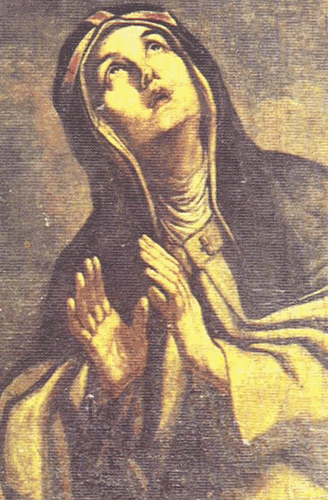 St. Bridget of Sweden…I never knew the power of the revelations to St. Bridget of Sweden until my friend Denise “reintroduced” them to me.  I say “reintroduced”, because I had bought the Pieta Prayer booklet (where they can be found) back in 1987. I offered them, really, only for a short while before packing the book away. But years later, after seeing how the revelations touched the heart of my
St. Bridget of Sweden…I never knew the power of the revelations to St. Bridget of Sweden until my friend Denise “reintroduced” them to me.  I say “reintroduced”, because I had bought the Pieta Prayer booklet (where they can be found) back in 1987. I offered them, really, only for a short while before packing the book away. But years later, after seeing how the revelations touched the heart of my dear friend, I dug the booklet out and started praying them again (as faithfully as I could). They are very powerful and beautiful. Meditating on the Passion of our Lord with the intensity called for in this particular devotion will change your life…are you ready?  How many of you out there have the Pieta prayer book and know the stories of St. Bridget of Sweden?
dear friend, I dug the booklet out and started praying them again (as faithfully as I could). They are very powerful and beautiful. Meditating on the Passion of our Lord with the intensity called for in this particular devotion will change your life…are you ready?  How many of you out there have the Pieta prayer book and know the stories of St. Bridget of Sweden?
(oh, be sure not to confuse her with St. Brigid of Kildare…it happens all the time)
Here  is the audio mp3 download of the 15 Prayers of St. Bridget as offered by Bruce McGregor and Denise Wharton
[powerpress ]
You can find the text for the prayers hereÂ
Here is the chapel in St. Paul’s Outside the Walls in Rome where St. Bridget received the private revelation of the 15 prayers…….
Of course, St. Bridget is more than just her prayers…ordinary woman, extraordinary life!. To learn more about St. Bridget of Sweden, take a look at this:
Tags: audio, feast day, Pieta Prayer, pieta prayer book, prayers, rome, st bridget of sweden, St. Paul Outside the Walls, Sweden, women of the middle ages
This entry was posted on Monday, July 23rd, 2012 at 1:00 am
You can follow any responses to this entry through the RSS 2.0 feed.
Bl. Teresa of St. Augustine and Companions (OCD), Virgins and Martyrs (m)
“These were a community of sixteen Discalced Carmelite nuns from the monastery of the Incarnation at Compiégne in France. When the full terror of the French Revolution began, they offered themselves as sacrificial victims to beg God for peace for the Church and for their country. Arrested and imprisoned on the 24th June 1794, they continued to share their joy and their faith with others. Condemned to death for their loyalty to the Church, to their religious vows and for their devotion to the Sacred Hearts of Jesus and Mary, they were guillotined in Paris on 17th July 1794 whilst singing hymns
and after having renewed their vows to their prioress, Teresa of St. Augustine. They were beatified by Saint Pius X on 13th May 1906.” from The Carmelite website
If you get a chance, listen to the beautifully provocative opera by Poulenc entitled “The Dialogues des Carmelites”…it’s stunning! The finale makes me cry every single time…(they are singing the Salve Regina, aka the Hail Holy Queen)
Take a look
Tags: carmelites. martyrs, french revolution, opera, poulenc
This entry was posted on Tuesday, July 17th, 2012 at 12:51 am
You can follow any responses to this entry through the RSS 2.0 feed.
.
Priscilla and Aquila
Dear Brothers and Sisters,
Taking a new step in this type of portrait gallery of the first witnesses of the Christian faith which we began some weeks ago, today we take into consideration a married couple.
The couple in question are Priscilla and Aquila, who take their place, as we already mentioned briefly last Wednesday, in the sphere of numerous collaborators who gravitated around the Apostle Paul. Based on the information in our possession, this married couple played a very active role in the post-Paschal origins of the Church.
The names Aquila and Priscilla are Latin, but the man and woman who bear them were of Hebrew origin. At least Aquila, however, geographically came from the diaspora of northern Anatolia, which faces the Black Sea – in today’s Turkey -, while Priscilla was probably a Jewish woman from Rome (cf. Acts 18: 2).
However, it was from Rome that they reached Corinth, where Paul met them at the beginning of the 50s. There he became associated with them, as Luke tells us, practicing the same trade of making tents or large draperies for domestic use, and he was even welcomed into their home (cf. Acts 18: 3).
The reason they came to Corinth was the decision taken by the Emperor Claudius to expel from Rome the city’s Jewish residents. Concerning this event the Roman historian Suetonius tells us that the Hebrews were expelled because “they were rioting due to someone named Chrestus” (cf. “The Lives of the Twelve Caesars, Claudius”, n. 25).
One sees that he did not know the name well – instead of Christ he wrote “Chrestus” – and he had only a very confused idea of what had happened. In any case, there were internal discords within the Jewish community about the question if Jesus was the Christ. And for the Emperor these problems were the reason to simply expel all Jews from Rome.
One can deduce that the couple had already embraced the Christian faith in the 40s, and now they had found in Paul someone who not only shared with them this faith – that Jesus is the Christ – but who was also an Apostle, personally called by the Risen Lord.
Therefore, their first encounter is at Corinth, where they welcomed him into their house and worked together making tents.
In a second moment they transferred to Ephesus in Asia Minor. There they had a decisive role in completing the Christian formation of the Alexandrian Jew Apollo, who we spoke about last Wednesday.
Since he only knew the faith superficially, “Priscilla and Aquila… took him and expounded to him the way of God more accurately” (Acts 18: 26).
When Paul wrote the First Letter to the Corinthians from Ephesus, together with his own greeting he explicitly sent those of “Aquila and Prisca, together with the church in their house” (16: 19).
Hence, we come to know the most important role that this couple played in the environment of the primitive Church: that of welcoming in their own house the group of local Christians when they gathered to listen to the Word of God and to celebrate the Eucharist. It is exactly this type of gathering that in Greek is called “ekklesìa” – the Latin word is “ecclesia”, the Italian “chiesa” – which means convocation, assembly, gathering.
In the house of Aquila and Priscilla, therefore, the Church gathered, the convocation of Christ, which celebrates here the Sacred Mysteries.
Thus, we can see the very birth of the reality of the Church in the homes of believers. Christians, in fact, from the first part of the third century did not have their own places of worship. Initially it was the Jewish Synagogue, until the original symbiosis between the Old and New Testaments dissolved and the Church of the Gentiles was forced to give itself its own identity, always profoundly rooted in the Old Testament.
Then, after this “break”, they gathered in the homes of Christians that thus become “Church”. And finally, in the third century, true and proper buildings for Christian worship were born.
But here, in the first half of the first century and in the second century, the homes of Christians become a true and proper “Church”. As I said, together they read the Sacred Scripture and celebrate the Eucharist.
That was what used to happen, for example, at Corinth, where Paul mentioned a certain “Gaius, who is host to me and to the whole church” (Rom 16: 23), or at Laodicea, where the community gathered in the home of a certain Nympha (cf. Col 4: 15), or at Colossae, where the meeting took place in the house of a certain Archippus (cf. Phlm 2).
Having returned subsequently to Rome, Aquila and Priscilla continue to carry out this precious function also in the capital of the Empire.
In fact, Paul, writing to the Romans, sends this precise greeting: “Greet Prisca and Aquila, my fellow workers in Christ Jesus, who risked their necks for my life, to whom not only I but also all the churches of the Gentiles give thanks; greet also the church in their house” (Rom 16: 3-5).
What extraordinary praise for these two married persons in these words! And it is none other than Paul who extends it. He explicitly recognizes in them two true and important collaborators of his apostolate. (more…)
Tags: catholic, catholic podcast, catholic prayer, cathollc spirituality
This entry was posted on Sunday, July 8th, 2012 at 12:01 am
You can follow any responses to this entry through the RSS 2.0 feed.
It is always a delight to talk with Fr. Robert Spitzer!  His sure brilliance, combined with his infectious joy 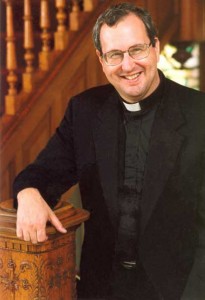 and good humor, is so engaging that any topic he leads us on becomes an adventure.  With “Cosmic Origins”, a soon to be released DVD, Fr. Spitzer and a group of physicists and academic heavyweights exploring modern scientific theories about how the universe came to exist.  I would call this a “mathematical apologetic”, which is so beautifully points to the greater “purpose” of our creator, that I couldn’t help but smile through the entire presentation.  Stunning, wonderful…and so much fun!
and good humor, is so engaging that any topic he leads us on becomes an adventure.  With “Cosmic Origins”, a soon to be released DVD, Fr. Spitzer and a group of physicists and academic heavyweights exploring modern scientific theories about how the universe came to exist.  I would call this a “mathematical apologetic”, which is so beautifully points to the greater “purpose” of our creator, that I couldn’t help but smile through the entire presentation.  Stunning, wonderful…and so much fun!
[powerpress]
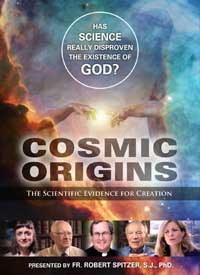 To learn more about this film and how you can arrange screenings for your parish or group go here
To learn more about this film and how you can arrange screenings for your parish or group go here
Cosmic Origins explains what we know about the beginning and nature of the universe, as well as its transcendent implications in clear, easy-to-understand terms. The 49-minute film weaves together a compelling narrative from academics and credentialed scientists pointing toward a very Catholic understanding of how the universe came to exist.
Cosmic Origins is distributed by Ignatius Press.
Tags: catholic, catholic podcast, catholic prayer, cathollc spirituality
This entry was posted on Friday, July 6th, 2012 at 9:55 am
You can follow any responses to this entry through the RSS 2.0 feed.
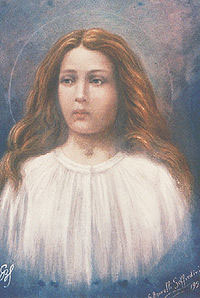
 MESSAGE OF JOHN PAUL II TO THE BISHOP OF ALBANO FOR THE CENTENARY OF THE DEATH OF ST. MARIA GORETTI from Vatican.va
MESSAGE OF JOHN PAUL II TO THE BISHOP OF ALBANO FOR THE CENTENARY OF THE DEATH OF ST. MARIA GORETTI from Vatican.va
To my Venerable Brother Bishop Agostino Vallini of Albano
1. A hundred years ago, on 6 July 1902, Maria Goretti died in the hospital at Nettuno, brutally stabbed the day before in the little village of Le Ferriere, in the Pontine Marshes. Her spiritual life, the strength of her faith, her ability to forgive her murderer have placed her among the best-loved saints of the 20th century. Appropriately, therefore, the Congregation of the Passion (C.P.), entrusted with the care of the shrine where the saint’s remains repose, wanted to celebrate the anniversary with special solemnity.
St Maria Goretti was a girl whom God’s Spirit endowed with the courage to stay faithful to her Christian vocation even to the point of making the supreme sacrifice of her life. Her tender age, her lack of education and the poverty of the environment in which she lived did not prevent grace from working its miracles in her. Indeed, it was precisely in these conditions that God’s special love for the lowly appeared. We are reminded of the words with which Jesus blesses the heavenly Father for revealing himself to children and the simple, rather than to the wise and learned of the world (cf. Mt 11,25).
It was rightly observed that St Maria Goretti’s martyrdom heralded what was to be known as the century of martyrs. It was in this perspective that at the end of the Great Jubilee of the Year 2000, I stressed that “this lively sense of repentance … has not prevented us from giving glory to the Lord for what he has done in every century, and in particular during the century which we have just left behind, by granting his Church a great host of saints and martyrs” (Novo Millennio ineunte, n. 7).
2. Maria Goretti, born in Corinaldo in The Marches on 16 October 1890, was soon obliged to emigrate with her family, and after sometime they arrived at Le Ferriere di Conca in the Pontine Marshes. Despite the hardships of poverty which even prevented her from going to school, little Maria lived in a serene and united family atmosphere, enlivened by Christian faith, in which the children felt welcomed as a gift and were taught by their parents self-respect and respect for others, as well as a sense of duty based on love of God. This enabled the little girl to grow up peacefully, nourishing her simple but deep faith. The Church has always recognized the role of the family as the first and fundamental place for the sanctification of its members, starting with the children.
In this family environment Maria assimilated steadfast trust in God’s provident love, which she showed in particular at the death of her father, who died of malaria. “Mother, be brave, God will help us”, the little girl was in the habit of saying in those difficult times, bravely reacting to her deep feeling of loss at her father’s death.
3. In the homily for her canonization, Pope Pius XII of venerable memory pointed to Maria Goretti as “the sweet little martyr of purity” (cf. Discorsi e Radiomessaggi, XII [1950-1951], 121), because she did not break God’s commandment in spite of being threatened by death.
What a shining example for young people! The non-commital mindset of much of our society and culture today sometimes has a struggle to understand the beauty and value of chastity. A high and noble perception of dignity, her own and that of others emerges from the behaviour of this young saint, was mirrored in her daily choices, giving them the fullness of human meaning. Is not there a very timely lesson in this? In a culture that idolizes the physical aspect of the relations between a man and a woman, the Church continues to defend and to champion the value of sexuality as a factor that involves every aspect of the person and must therefore be lived with an interior attitude of freedom and reciprocal respect, in the light of God’s original plan. With this outlook, a person discovers he or she is being given a gift and is called, in turn, to be a gift to the other. (more…)
Tags: catholic, catholic podcast, catholic prayer, cathollc spirituality, Church, forgiveness, Le Ferriere, Maria Goretti, pope john paul ii, saints, st. maria goretti
This entry was posted on Friday, July 6th, 2012 at 12:07 am
You can follow any responses to this entry through the RSS 2.0 feed.
Published on Jun 23, 2012 by catholicpeter
This is the first part of two videos which show a selection of the great words and teachings of our Lord and Saviour Jesus Christ. I have only included a handful, probably the most well known. For every word that proceeded from His mouth was wonderful. The quotes are taken from the RSV-CE, RSV, and DRB Bibles. There are various images showing Christs life throughout.
Tags: catholic, catholic podcast, catholic prayer, cathollc spirituality, Lord Jesus Christ, Saviour Jesus Christ, sermon on mount, Visual Meditation
This entry was posted on Saturday, June 30th, 2012 at 1:39 pm
You can follow any responses to this entry through the RSS 2.0 feed.
From the Vatican.va archives June 24, 2007:
Today, 24 June, the liturgy invites us to celebrate the Solemnity of the Birth of St John the Baptist, whose life was totally directed to Christ, as was that of Mary, Christ’s Mother.
John the Baptist was the forerunner, the “voice” sent to proclaim the Incarnate Word. Thus, commemorating his birth actually means celebrating Christ, the fulfilment of the promises of all the prophets, among whom the greatest was the Baptist, called to “prepare the way” for the Messiah (cf. Mt 11: 9-10).
All the Gospels introduce the narrative of Jesus’ public life with the account of his baptism by John in the River Jordan. St Luke frames the Baptist’s entrance on the scene in a solemn historical setting.
My book Jesus of Nazareth also begins with the Baptism of Jesus in the Jordan, an event which had enormous echoes in his day. People flocked from Jerusalem and every part of Judea to listen to John the Baptist and have themselves baptized in the river by him, confessing their sins (cf. Mk 1: 5).
The baptizing prophet became so famous that many asked themselves whether he was the Messiah. The Evangelist, however, specifically denied this: “I am not the Christ” (Jn 1: 20).Nevertheless, he was the first “witness” of Jesus, having received instructions from Heaven: “He on whom you see the Spirit descend and remain, this is he who baptizes with the Holy Spirit” (Jn 1: 33).
This happened precisely when Jesus, after receiving baptism, emerged from the water: John saw the Spirit descending upon him in the form of a dove. It was then that he “knew” the full reality of Jesus of Nazareth and began to make him “known to Israel” (Jn 1: 31), pointing him out as the Son of God and Redeemer of man: “Behold, the Lamb of God, who takes away the sin of the world!” (Jn 1: 29).As an authentic prophet, John bore witness to the truth without compromise. He denounced transgressions of God’s commandments, even when it was the powerful who were responsible for them. Thus, when he accused Herod and Herodias of adultery, he paid with his life, sealing with martyrdom his service to Christ who is Truth in person.
Let us invoke his intercession, together with that of Mary Most Holy, so that also in our day the Church will remain ever faithful to Christ and courageously witness to his truth and his love for all.
Tags: catholic, catholic podcast, catholic prayer, cathollc spirituality, john the baptist, pope benedict xvi
This entry was posted on Sunday, June 24th, 2012 at 7:23 am
You can follow any responses to this entry through the RSS 2.0 feed.
Who is Aloysius Gonzaga?
I didn’t know anything about him until I traveled to Rome and visited the Church of St. Igantius of Loyola. Â I encountered this beautiful altar dedicated to this young saint who died at the age of 23. Â I wanted to learn about this youth who was so highly venerated by the Society of Jesus, who even someone as great as St. Robert Bellarmine wanted to be buried near. His story is poignant and a strong witness to the power of grace, no wonder they love him so.
from Gonzaga.edu
Aloysius is the Latin form of Gonzaga’s given name, Luigi. In English, the equivalent form would be Louis. The Gonzaga name is well known in Italy. Aloysius Gonzaga was born at Castiglione near Mantua, Italy, in 1568 to a celebrated family of wealth and prestige. As the first born son of his father, Ferrante, and his mother, Marta, he was in line to inherit his father’s title of Marquis. He grew up amid the violence and brutality of the Renaissance Italy and witnessed the murder of two of his brothers. In 1576, Aloysius’ parents sent him to attend the court of the Grand Duke of Tuscany, Francesco de’Medici, in Florence. Later, accompanied by his parents, he traveled to Spain to join the court of Philip II in Madrid.
In Spain, Aloysius decided he wanted to join the newly founded religious order, The Society of Jesus. His father resisted his decision and there followed a struggle of wills that continued after his return to Castiglione in 1584. But Aloysius eventually prevailed.
Renouncing his right to the title of Marquis and to the vast wealth he was destined to inherit, he entered the Society of Jesus in Rome on November 25, 1585. Â During his early studies in Rome, he would regularly go out into the streets of the city to care for victims of the plague. He himself contracted the disease as a result of his efforts for the suffering
and died on June 21, 1591, at the age of twenty-three, six years short of his ordination as a Jesuit priest.
Even before his time as a Jesuit, Aloysius was known for his love of prayer and fasting. He received his First Communion from St. Charles Borromeo. As a Jesuit at the Roman College, he continued to devote his time to prayer and practices of austerity. His spiritual director was Robert Bellarmine who later was canonized and declared a doctor of the church. When Robert was dying, he asked to be buried next to the grave of Aloysius. Today, they rest next to each other in the church of St. Ignatius Loyola in Rome. Pope Benedict XIII canonized Aloysius in 1726, and three years later declared him to be the patron of youth in the Catholic Church, an honor later confirmed by Pope Pius XI in 1926.
Tags: Aloysius Gonzaga, catholic, catholic podcast, catholic prayer, cathollc spirituality, jesuits, Robert Bellarmine, society of jesus, st robert bellarmine, St. Aloysius Gonzaga, youth
This entry was posted on Thursday, June 21st, 2012 at 3:28 pm
You can follow any responses to this entry through the RSS 2.0 feed.
Beatification of Sister Marguerite Rutan,
June 19, 2011
From the Daughter of Charity of St. Vincent de Paul website:
“The lives of the saints are not limited to their earthly biographies but also include their being and working in God after death. In the saints one thing becomes clear: those who draw near to God do not withdraw from men, but rather become truly close to them.â€(Deus Caritas est 42).
In February 2011 we published a short article on Sister Marguerite Rutan, Daughter of Charity and martyr (see www.filles-de-la-charite.org/en/news). As her beatification approaches we invite you to learn more about her life. Who is this new example of Vincentian holiness?
A presentation of her life:
Marguerite Rutan was born on 23 April 1736 in Metz in Lorraine and was baptized the same day. Marguerite was the 8th of 15 children. Marie Forat, her mother, was very Christian and her father, Charles Gaspard Rutan was an honest and courageous workman. With them she learned to live her life as a gift from God.
Her father introduced her to mathematics and linear design. Soon she was able to keep the accounts of his business. She helped with all her family until she was 21 years old.
She had the profound conviction she was being called by Jesus. With Him she looked for a way to give herself to the service of those who were poor.
In 1756, Marguerite Rutan entered the Company of the Daughters of Charity to be near those who were suffering, marginalized or excluded. She wanted to serve them. Following Christ she encouraged charity in those around her. For over 20 years she placed everything she received from God and others at the service of the poorest of the poor, no matter where she was sent by her superiors.
In 1779 she was sent to serve in the Hospital of Dax. Sr. Marguerite and her Sisters worked for 10 years relating with the townspeople. The Sisters were admired and respected.
In 1789 the troubling period of the Revolution began. It profoundly changed the country and personally touched Sr. Marguerite with suffering and death (April 9, 1794). Her faithfulness to Christ and the Church lead her to martyrdom. The life of Sr. Marguerite was anchored in the person of Christ and his Word. Each day she profoundly encountered the love of Christ which drew her to serve as He served.
Following Christ, servant of her brothers and sisters, kneeling to wash their feet, Sr. Marguerite gave her life to serve the poor and the sick and building brotherhood with all.
Following Christ, servant of the will of the Father, Sr. Marguerite based her life on the Gospel, desiring only one thing: to do the will of God.
Following Christ, servant of the suffering, despised, persecuted, Sr. Marguerite abandoned herself totoally to God. During the revolutionary turmoil, she showed the extremity of her love.
Interesting links:
Marguerite Rutan: A little history of her life
Tags: Blessed Marguerite Rutan, catholic, catholic podcast, catholic prayer, cathollc spirituality, daughters of charity, france, french revolution, Marguerite Rutan, martyr, martyrdom, Sister Marguerite Rutan
This entry was posted on Thursday, June 21st, 2012 at 1:16 pm
You can follow any responses to this entry through the RSS 2.0 feed.
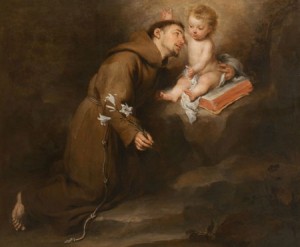
Saint Anthony of Padua from vatican.va
Dear Brothers and Sisters,
Two weeks ago I presented St Francis of Assisi. This morning I would like to speak of another saint who belonged to the first generation of the Friars Minor: Anthony of Padua, or of Lisbon, as he is also called with reference to his native town. He is one of the most popular Saints in the whole Catholic Church, venerated not only in Padua, where a splendid Basilica has been built that contains his mortal remains, but also throughout the world. Dear to the faithful are the images and statues that portray him with the lily a symbol of his purity or with the Child Jesus in his arms, in memory of a miraculous apparition mentioned in several literary sources.
With his outstanding gifts of intelligence, balance, apostolic zeal and, primarily, mystic fervour, Anthony contributed significantly to the development of Franciscan spirituality.
He was born into a noble family in Lisbon in about 1195 and was baptized with the name of Fernando. He entered the Canons who followed the monastic Rule of St Augustine, first at St Vincent’s Monastery in Lisbon and later at that of the Holy Cross in Coimbra, a renowned cultural centre in Portugal. He dedicated himself with interest and solicitude to the study of the Bible and of the Church Fathers, acquiring the theological knowledge that was to bear fruit in his teaching and preaching activities. The event that represented a decisive turning point on his life happened in Coimbra. It was there, in 1220, that the relics were exposed of the first five Franciscan missionaries who had gone to 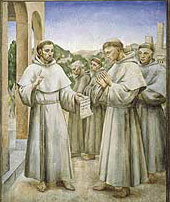 Morocco, where they had met with martyrdom. Their story inspired in young Fernando the desire to imitate them and to advance on the path of Christian perfection. Thus he asked to leave the Augustinian Canons to become a Friar Minor. His request was granted and, having taken the name of Anthony, he too set out for Morocco, but divine Providence disposed otherwise. After an illness he was obliged to return to Italy and, in 1221, participated in the famous “Chapter of the Mats” in Assisi, where he also met St Francis. He then lived for a period in complete concealment in a convent at Forlì in northern Italy, where the Lord called him to another mission. Invited, in somewhat casual circumstances, to preach on the occasion of a priestly ordination, he showed himself to be endowed with such knowledge and eloquence that the Superiors assigned him to preaching. Thus he embarked on apostolic work in Italy and France that was so intense and effective that it induced many people who had left the Church to retrace their footsteps. Anthony was also one of the first if not the first theology teachers of the Friars Minor. He began his teaching in Bologna with the blessing of St Francis who, recognizing Anthony’s virtues, sent him a short letter that began with these words: “I would like you to teach the brethren theology”. Anthony laid the foundations of Franciscan theology which, cultivated by other outstanding thinkers, was to reach its apex with St Bonaventure of Bagnoregio and Bl. Duns Scotus.
Morocco, where they had met with martyrdom. Their story inspired in young Fernando the desire to imitate them and to advance on the path of Christian perfection. Thus he asked to leave the Augustinian Canons to become a Friar Minor. His request was granted and, having taken the name of Anthony, he too set out for Morocco, but divine Providence disposed otherwise. After an illness he was obliged to return to Italy and, in 1221, participated in the famous “Chapter of the Mats” in Assisi, where he also met St Francis. He then lived for a period in complete concealment in a convent at Forlì in northern Italy, where the Lord called him to another mission. Invited, in somewhat casual circumstances, to preach on the occasion of a priestly ordination, he showed himself to be endowed with such knowledge and eloquence that the Superiors assigned him to preaching. Thus he embarked on apostolic work in Italy and France that was so intense and effective that it induced many people who had left the Church to retrace their footsteps. Anthony was also one of the first if not the first theology teachers of the Friars Minor. He began his teaching in Bologna with the blessing of St Francis who, recognizing Anthony’s virtues, sent him a short letter that began with these words: “I would like you to teach the brethren theology”. Anthony laid the foundations of Franciscan theology which, cultivated by other outstanding thinkers, was to reach its apex with St Bonaventure of Bagnoregio and Bl. Duns Scotus.
Having become Provincial Superior of the Friars Minor in northern Italy, he continued his ministry of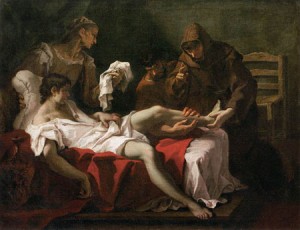 preaching, alternating it with his office of governance. When his term as Provincial came to an end, he withdrew to a place near Padua where he had stayed on various other occasions. Barely a year later, he died at the city gates on 13 June 1231. Padua, which had welcomed him with affection and veneration in his lifetime, has always accorded him honour and devotion. Pope Gregory IX himself, having heard him preach, described him as the “Ark of the Testament” and subsequent to miracles brought about through his intercession canonized him in 1232, only a year after his death.
preaching, alternating it with his office of governance. When his term as Provincial came to an end, he withdrew to a place near Padua where he had stayed on various other occasions. Barely a year later, he died at the city gates on 13 June 1231. Padua, which had welcomed him with affection and veneration in his lifetime, has always accorded him honour and devotion. Pope Gregory IX himself, having heard him preach, described him as the “Ark of the Testament” and subsequent to miracles brought about through his intercession canonized him in 1232, only a year after his death.
In the last period of his life, Anthony put in writing two cycles of “Sermons”, entitled respectively “Sunday Sermons” and “Sermons on the Saints” destined for the Franciscan Order’s preachers and teachers of theological studies. In these Sermons he commented on the texts of Scripture presented by the Liturgy, using the patristic and medieval interpretation of the four senses: the literal or historical, the allegorical or Christological, the tropological or moral, and the anagogical, which orients a person to eternal life. Today it has been rediscovered that these senses are dimensions of the one meaning of Sacred Scripture and that it is right to interpret Sacred Scripture by seeking the four dimensions of its words. St Anthony’s sermons are theological and homiletical texts that echo the live preaching in which Anthony proposes a true and proper itinerary of Christian life. The richness of spiritual teaching contained in the “Sermons” was so great that in 1946 Venerable Pope Pius XII proclaimed Anthony a Doctor of the Church, attributing to him the title “Doctor Evangelicus”, since the freshness and beauty of the Gospel emerge from these writings. We can still read them today with great spiritual profit.
In these Sermons St Anthony speaks of prayer as of a loving relationship that impels man to speak gently with the Lord, creating an ineffable joy that sweetly enfolds the soul in prayer. Anthony reminds us that prayer requires an atmosphere of silence, which does not mean distance from external noise but rather is an interior experience that aims to remove the distractions caused by a soul’s anxieties, thereby creating silence in the soul itself. According to this prominent Franciscan Doctor’s teaching, prayer is structured in four indispensable attitudes which in Anthony’s Latin are defined as obsecratio, oratio, postulatio, gratiarum actio. We might translate them in the following manner. The first step in prayer is confidently opening one’s heart to God; this is not merely accepting a word but opening one’s heart to God’s presence. Next, is speaking with him affectionately, seeing him present with oneself; then a very natural thing presenting our needs to him; and lastly, praising and thanking him.
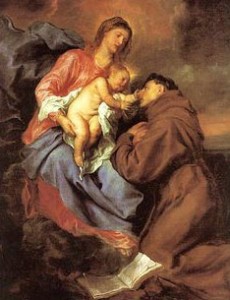 In St Anthony’s teaching on prayer we perceive one of the specific traits of the Franciscan theology that he founded: namely the role assigned to divine love which enters into the sphere of the affections, of the will and of the heart, and which is also the source from which flows a spiritual knowledge that surpasses all other knowledge. In fact, it is in loving that we come to know.
In St Anthony’s teaching on prayer we perceive one of the specific traits of the Franciscan theology that he founded: namely the role assigned to divine love which enters into the sphere of the affections, of the will and of the heart, and which is also the source from which flows a spiritual knowledge that surpasses all other knowledge. In fact, it is in loving that we come to know.
Anthony writes further: “Charity is the soul of faith, it gives it life; without love, faith dies” (Sermones Dominicales et Festivi II, Messagero, Padua 1979, p. 37).
Tags: Anthony of Padua, catholic, catholic podcast, catholic prayer, cathollc spirituality, doctor of the church, franciscan, franciscan priest, franciscan spirituality, pope benedict xvi, Saint Anthony of Padua, st anthony, st. anthony of padua
This entry was posted on Wednesday, June 13th, 2012 at 7:00 am
You can follow any responses to this entry through the RSS 2.0 feed.
 PRAYER TO ST ANTHONY TO FIND SOMETHING LOST
PRAYER TO ST ANTHONY TO FIND SOMETHING LOST
Glorious St Anthony, perfect imitator of Jesus, who received from God the special power of restoring lost things, grant that I may find … which has been lost. At least restore my peace and tranquillity of mind, the loss of which has afflicted me even more than my material loss. To this favour I ask another of you: that I may always remain in possession of the true good that is God. Let me rather lose all things than lose God, my supreme good. Let me never suffer the loss of my greatest treasure, eternal life with God.
Amen.
Tags: catholic, catholic podcast, catholic prayer, cathollc spirituality, special power, st anthony, st. anthony of padua, Warrior of God PRAYER TO ST ANTHONY
This entry was posted on Wednesday, June 13th, 2012 at 6:53 am
You can follow any responses to this entry through the RSS 2.0 feed.
“The heavens show forth the glory of God, and thefirmament declares the work of his hands” Ps 19:1 (New Advent Online Bible)
Tags: catholic, catholic podcast, catholic prayer, cathollc spirituality
This entry was posted on Thursday, May 10th, 2012 at 1:27 pm
You can follow any responses to this entry through the RSS 2.0 feed.
Vatican City, 2 May 2012 (VIS) – 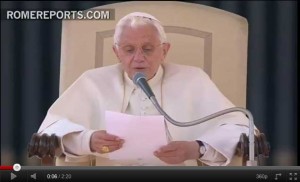
The prayer of St. Stephen, the first Christian martyr, was the theme of the Holy Father’s catechesis during his general audience this morning.
Addressing more than 20,000 faithful filling St. Peter’s Square, the Pope explained how, according to the narrative of the Acts of the Apostles, Stephen was taken before the Sanhedrin accused of having declared that Jesus would destroy the Temple and change the customs handed down by Moses. In his address before the council Stephen explained that, in saying these things, Jesus had been referring to His body, which was the new temple. In this way, Christ “inaugurated the new worship and, with the offer of Himself on the cross, replaced the ancient sacrifices”, Benedict XVI said.
Stephen wished to show that the accusation of subverting the Law of Moses was unfounded, to which end he outlined his view of the history of salvation, of the covenant between God and man. “Thus”, the Holy Father explained, “he reread the entire biblical narrative to show that it led to the ‘place’ of God’s definitive presence, which is Jesus Christ and in particular His passion, death and resurrection. Stephen interpreted his status as a disciple of Jesus in the same light, … following Him to martyrdom. Thus, meditation upon Sacred Scripture helped him to understand … the present”.
“In his meditation upon God’s action in the history of salvation” the proto-martyr “highlighted the perennial temptation to reject God and His acts, and affirmed that Jesus is the Just One announced by the prophets. In Him, God made Himself definitively and uniquely present: Jesus is the ‘place’ of true worship”.
Stephen’s explanations and his life were interrupted by his stoning, yet “martyrdom was the culmination of his life and message, because he became one with Christ. Thus his meditation upon the action of God in history, on the divine Word which was entirely fulfilled in Jesus, became a form of participation in Christ’s prayer on the cross”.
The moment of Stephen’s martyrdom “again revealed the fruitful relationship between the Word of God and prayer”, the Pope said. Yet “where did this first Christian martyr find the strength to face his persecutors and to make the ultimate gift of self? The answer is simple: in his relationship with God, in his communion with Christ, in meditating upon the history of salvation, in witnessing the action of God which reached its apex in Jesus Christ”.
St. Stephen believed that Jesus was “the Temple, ‘not made by human hands’, in which the presence of God the Father came so close as to enter our human flesh, bringing us to God and opening the doors of heaven for us. Our prayer must, then, be contemplation of Jesus sitting at the right hand of God, of Jesus as Lord of our daily life. In Him, under the guidance of the Holy Spirit, we too can address God … with the trust and abandonment of children who turn to a Father Who loves them with an infinite love”.
Tags: catholic, catholic podcast, catholic prayer, cathollc spirituality, jesus christ, pope benedict, pope benedict xvi, scripture, st. stephen
This entry was posted on Thursday, May 3rd, 2012 at 7:40 am
You can follow any responses to this entry through the RSS 2.0 feed.
Dominican Tertiary, born at Siena, 25 March, 1347; died at Rome, 29 April, 1380.
From the Catholic Encyclopedia, found at New Advent –
She was the youngest  one of a very large family. Her father, Giacomo di Benincasa, was a dyer; her mother, Lapa, the daughter of a local poet. They belonged to the lower middle-class faction of tradesmen and petty notaries, known as “the Party of the Twelve”, which between one revolution and another ruled the Republic of Siena from 1355 to 1368. From her earliest childhood Catherine began to see visions and to practise extreme austerities. At the age of seven she consecrated her virginity to Christ; in her sixteenth year she took the habit of the Dominican Tertiaries, and renewed the life of the anchorites of the desert in a little room in her father’s house. After three years of celestial visitations and familiar conversation with Christ, she underwent the mystical experience known as the “spiritual espousals”, probably during the carnival of 1366. She now rejoined her family, began to tend the sick, especially those afflicted with the most repulsive diseases, to serve the poor, and to labour for the conversion of sinners.Though always suffering terrible physical pain, living for long intervals on practically no food save the Blessed Sacrament, she was ever radiantly happy and full of practical wisdom no less than the highest spiritual insight. All her contemporaries bear witness to her extraordinary personal charm, which prevailed over the continual persecution to which she was subjected even by the friars of her own order and by her sisters in religion.
She began to gather disciples round her, both men and women, who formed a wonderful spiritual fellowship, united to her by the bonds of mystical love. During the summer of 1370 she received a series of special manifestations of Divine mysteries, which culminated in a prolonged trance, a kind of mystical death, in which she had a vision of Hell, Purgatory, and Heaven, and heard a Divine command to leave her cell and enter the public life of the world. She began to dispatch letters to men and women in every condition of life, entered into correspondence with the princes and republics of Italy, was consulted by the papal legates about the affairs of the Church, and set herself to heal the wounds of her native land by staying the fury of civil war and the ravages of faction. She implored the pope, Gregory XI, to leave Avignon, to reform the clergy and the administration of the Papal States, and ardently threw herself into his design for a crusade, in the hopes of uniting the powers of Christendom against the infidels, and restoring peace to Italy by delivering her from the wandering companies of mercenary soldiers. While at Pisa, on the fourth Sunday of Lent, 1375, she received the Stigmata, although, at her special prayer, the marks did not appear outwardly in her body while she lived.
Mainly through the misgovernment of the papal officials, war broke out between Florence and the Holy See, andalmost the whole of the Papal States rose in insurrection. Catherine had already been sent on a mission from the pope to secure the neutrality of Pisa and Lucca.
In June, 1376, she went to Avignon as ambassador of the Florentines, to make their peace; but, either through the bad faith of the republic or through a misunderstanding caused by the frequent changes in its government, she was unsuccessful. Nevertheless she made such a profound impression upon the mind of the pope, that, in spite of the opposition of the French king and almost the whole of the Sacred College, he returned to Rome (17 January, 1377).
Catherine spent the greater part of 1377 in effecting a wonderful spiritual revival in the country districts subject to the Republic of Siena, and it was at this time that she miraculously learned to write, though she still seems to have chiefly relied upon her secretaries for her correspondence. Early in 1378 she was sent by Pope Gregory to Florence, to make a fresh effort for peace. Unfortunately, through the factious conduct of her Florentine associates, she became involved in the internal politics of the city, and during a popular tumult (22 June) an attempt was made upon her life. She was bitterly disappointed at her escape, declaring that her sins had deprived her of the red rose of martyrdom. Nevertheless, during the disastrous revolution known as “the tumult of the Ciompi”, she still remained at Florence or in its territory until, at the beginning of August, news reached the city that peace had been signed between the republic and the new pope. Catherine then instantly returned to Siena, where she passed a few months of comparative quiet, dictating her “Dialogue”, the book of her meditations and revelations.
In the meanwhile the Great Schism had broken out in the Church. From the outset Catherine enthusiastically adhered to the Roman claimant, Urban VI, who in November, 1378, summoned her to Rome. In the Eternal City she spent what remained of her life, working strenuously for the reformation of the Church, serving the destitute and afflicted, and dispatching eloquent letters in behalf of Urban to high and low in all directions. Her strength was rapidly being consumed; she besought her Divine Bridegroom to let her bear the punishment for all the sins of the world, and to receive the sacrifice of her body for the unity and renovation of the Church; at last it seemed to her that the Bark of Peter was laid upon her shoulders, and that it was crushing her to death with its weight. After a prolonged and mysterious agony of three months, endured by her with supreme exultation and delight, from Sexagesima Sunday until the Sunday before the Ascension, she died. Her last political work, accomplished practically from her death-bed, was the reconciliation of Pope Urban VI with the Roman Republic (1380).
Among Catherine’s principal followers were Fra Raimondo delle Vigne, of Capua (d. 1399), her confessor and biographer, afterwards General of the Dominicans, and Stefano di Corrado Maconi (d. 1424), who had been one of her secretaries, and became Prior General of the Carthusians. Raimondo’s book, the “Legend”, was finished in 1395. A second life of her, the “Supplement”, was written a few years later by another of her associates, Fra Tomaso Caffarini (d. 1434), who also composed the “Minor Legend”, which was translated into Italian by Stefano Maconi. Between 1411 and 1413 the depositions of the surviving witnesses of her life and work were collected at Venice, to form the famous “Process”. Catherine was canonized by Pius II in 1461. The emblems by which she is known in Christian art are the lily and book, the crown of thorns, or sometimes a heart–referring to the legend of her having changed hearts with Christ. Her principal feast is on the 30th of April, but it is popularly celebrated in Siena on the Sunday following. The feast of her Espousals
is kept on the Thursday of the carnival.
The works of St. Catherine of Siena rank among the classics of the Italian language, written in the beautiful Tuscan vernacular of the fourteenth century. Notwithstanding the existence of many excellent manuscripts, the printed editions present the text in a frequently mutilated and most unsatisfactory condition. Her writings consist of
the “Dialogue”, or “Treatise on Divine Providence”;
a collection of nearly four hundred letters; and
a series of “Prayers”.The “Dialogue” especially, which treats of the whole spiritual life of man in the form of a series of colloquies between the Eternal Father and the human soul (represented by Catherine herself), is the mystical counterpart in prose of Dante’s “Divina Commedia”.
A smaller work in the dialogue form, the “Treatise on Consummate Perfection”, is also ascribed to her, but is probably spurious. It is impossible in a few words to give an adequate conception of the manifold character and contents of the “Letters”, which are the most complete expression of Catherine’s many-sided personality. While those addressed to popes and sovereigns, rulers of republics and leaders of armies, are documents of priceless value to students of history, many of those written to private citizens, men and women in the cloister or in the world, are as fresh and illuminating, as wise and practical in their advice and guidance for the devout Catholic today as they were for those who sought her counsel while she lived. Others, again, lead the reader to mystical heights of contemplation, a rarefied atmosphere of sanctity in which only the few privileged spirits can hope to dwell. The key-note to Catherine’s teaching is that man, whether in the cloister or in the world, must ever abide in the cell of self-knowledge, which is the stable in which the traveller through time to eternity must be born again.
More on St. Catherine of Siena
Tags: catholic, catholic podcast, catholic prayer, cathollc spirituality, doctor of the church, mystic, mystical experience, prayer
This entry was posted on Sunday, April 29th, 2012 at 12:55 am
You can follow any responses to this entry through the RSS 2.0 feed.

